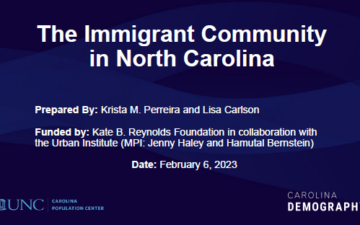Estimating future first-generation college students

As part of our work on the county attainment profiles with myFutureNC, we regularly identify new data sources and metrics that help answer questions we are hearing from local stakeholders. For example, we developed county-level opportunity youth metrics to provide county leaders information on how 16-24-year-olds in their communities are doing with respect to work and school.
We used this same methodological approach to develop another new county indicator: the share of children who would be first-generation in college students, based on the current educational attainment of their parents or guardian.
These are individuals ages 0-17 whose parents have not earned an associate degree or higher. If the children are not living with a parent, this is based on the highest education of the head of household.
We used the 2015-2019 American Community Survey microdata from IPUMS-USA to calculate county-specific rates of potential first-generation children. For twenty North Carolina counties, we can calculate these rates directly. For the remaining eighty counties, we estimated the first-generation child population based on the county population ages 0-17 by race and ethnicity during 2015-2019 and the race-specific rates of first-generation in college for the county or the county’s parent PUMA. (You can read the full methodology here.)
Statewide, nearly 1.2 million North Carolina children would be first-generation in college students – meaning they live in a household where the highest educational attainment of their parent or household head is less than an associate degree. This represents just under half—49%—of all North Carolina children. Hispanic children are the most likely to be first-generation in college (74%), followed by Black (63%), and all other races (48%), which includes American Indian, Asian, and Multiracial. White children are the least likely to be first-generation in college (36%).
The counties with the highest proportion of potential first-generation in college children are in the Sandhills region: Anson (71.2%), Robeson (71%), Duplin (70.3%), Bladen (69.6%), and Sampson (69.3%). Across these counties, the majority of children from all racial/ethnic groups are likely to be first-generation in college, with the highest rates among Hispanic children (89-97% potential first-generation).
Children in Orange County (23.5%) are the least likely to be first-generation in college, followed by Wake (29.4%), reflecting the high rates of adult educational attainment in these counties. These low rates of potential first-generation in college children mask larger gaps between White children and Hispanic and Black children:
The largest number of potential first-generation in college students is in Mecklenburg County—104K or one in every eleven potential first-generation children in the state. Wake (75K) has the next largest number followed by Guilford (56K), Forsyth (46K), Cumberland (42K), and Durham (31K).
Learn more:
From our high schools to our colleges: First-generation in North Carolina (EdNC)
Need help understanding population change and its impacts on your community or business? Carolina Demography offers demographic research tailored to your needs.
Contact us today for a free initial consultation.
Contact UsCategories: Education

The Center for Women’s Health Research (CWHR) at the University of North Carolina School of Medicine released the 12th edition of our North Carolina Women’s Health Report Card on May 9, 2022. This document is a progress report on the…

Dr. Krista Perreira is a health economist who studies disparities in health, education, and economic well-being. In collaboration with the Urban Institute, she recently co-led a study funded by the Kate B. Reynolds Foundation to study barriers to access to…

Our material helped the NC Local News Lab Fund better understand and then prioritize their funding to better serve existing and future grant recipients in North Carolina. The North Carolina Local News Lab Fund was established in 2017 to strengthen…
Your support is critical to our mission of measuring, understanding, and predicting population change and its impact. Donate to Carolina Demography today.